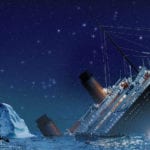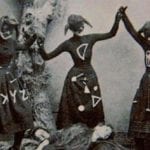 History
History  History
History  Movies and TV
Movies and TV 10 Actors Who Infamously Stormed Off Set While Filming
 Food
Food 10 Foods That Have Alleged Occult Powers
 Sport
Sport 10 Lesser-Known Multi-Sport Alternatives to the Olympics
 Humans
Humans 10 Real Life Versions of Famous Superheroes
 Gaming
Gaming 10 Overused Game Villains
 Mysteries
Mysteries Ten Mysterious “Ghost Ship” Stories That Still Keep Us Wondering
 Technology
Technology 10 Times AI Replaced Humans (and No One Noticed)
 Politics
Politics 10 Dreaded Despots Who Met Untimely Deaths
 Pop Culture
Pop Culture 10 Celebs Who Have Surprisingly Wanted to Be on Reality TV
 History
History Ten of History’s Hidden Secrets: Stories 99% Don’t Know About
 Movies and TV
Movies and TV 10 Actors Who Infamously Stormed Off Set While Filming
 Food
Food 10 Foods That Have Alleged Occult Powers
Who's Behind Listverse?

Jamie Frater
Head Editor
Jamie founded Listverse due to an insatiable desire to share fascinating, obscure, and bizarre facts. He has been a guest speaker on numerous national radio and television stations and is a five time published author.
More About Us Sport
Sport 10 Lesser-Known Multi-Sport Alternatives to the Olympics
 Humans
Humans 10 Real Life Versions of Famous Superheroes
 Gaming
Gaming 10 Overused Game Villains
 Mysteries
Mysteries Ten Mysterious “Ghost Ship” Stories That Still Keep Us Wondering
 Technology
Technology 10 Times AI Replaced Humans (and No One Noticed)
 Politics
Politics 10 Dreaded Despots Who Met Untimely Deaths
 Pop Culture
Pop Culture 10 Celebs Who Have Surprisingly Wanted to Be on Reality TV
Top 10 Misconceptions About The Titanic Debunked
As the 105th anniversary of its sinking approaches, it’s clear that the Titanic shows no signs of fading from society’s collective memory. Over the past century, a great number of legends and stories about her and those aboard have been told and repeated. Some are true, and some are factually distorted and have become cemented in popular lore as a result. Here are ten common misconceptions about the Titanic and her terrible demise.
10 The First SOS
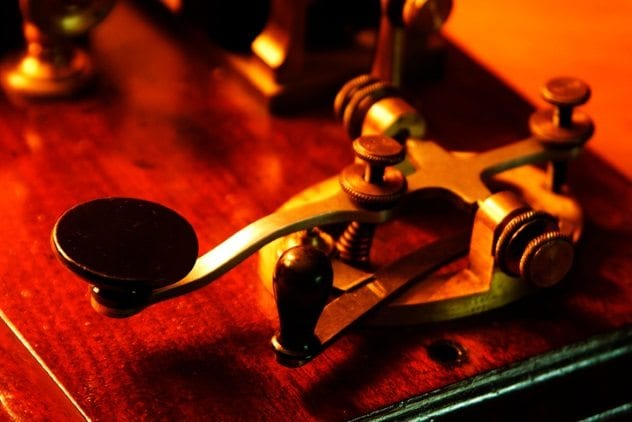
One of the most enduring Titanic myths still thrown at unsuspecting trivia fans to this day is the claim that Titanic was the first ship to use the “SOS” distress signal. Like most myths and legends, there’s a grain of truth that has been twisted and distorted into a more dramatic-sounding tidbit. It comes from the account of a conversation between Titanic‘s wireless operators, Harold Bride and Jack Phillips, after the collision with the iceberg. Bride jokingly suggested that Phillips take the opportunity to use the new “SOS” distress call, as it may be his last chance to send it.
In the years before Titanic‘s sinking, there was no specific, internationally recognized standard distress call for a ship in distress. At the time, British ships tended to use the call “CQD,” which stood for “SEEK YOU—DANGER/DISTRESS.” In 1906, a wireless communication conference attempted to put an end to the confusion and pick a standard call that everyone could recognize. They opted for “SOS,” which, contrary to popular belief, did not actually stand for anything at all. The letters were chosen because they were both easy to transmit and easy to recognize, due to their distinctive pattern. Even a novice operator could manage them if necessary.
However, as is often the case, many chose to stick with the familiar, and British ships generally continued to primarily use “CQD,” and the Titanic was no different. After the collision, Phillips initially transmitted “CQD,” prompting Bride’s suggestion to use “SOS,” too. While “SOS” was still relatively new, by 1912, it had already been in use for years (even if it wasn’t an operator’s first choice). Titanic‘s use of “SOS” did, however, mark a more major adoption of the signal by British ships, and “SOS” is still recognized as a visual distress signal today.
9 The Lookouts Didn’t See The Iceberg Because They Didn’t Have Binoculars
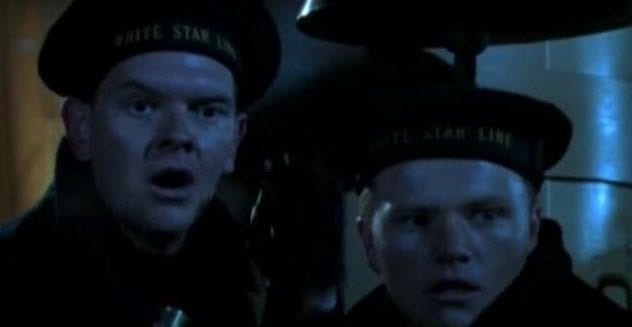
It’s long been known that Titanic‘s lookouts didn’t have any binoculars during their voyage across the Atlantic, and it’s often claimed that if they had, they would have spotted the iceberg in time. At the British inquiry into the sinking, Lookout Frederick Fleet, who had been on duty when Titanic struck the iceberg, said as much. Is that the case? And if so, why weren’t they provided any?
To begin with, Titanic‘s lookouts actually were provided with binoculars, or at least, that was the plan. There was even a special storage place for them in the crow’s nest. When a ship was in port, it was common for the lookout’s binoculars to be locked up safely. Once the voyage began, the lookouts would then receive them. When Titanic departed Belfast, it became clear that the lookouts’ binoculars were missing, so the second officer promptly lent his own pair to them. On arrival in Southampton, he asked for the binoculars to be returned and locked up in his cabin. Just before Titanic left Southampton, there was a last-minute officer reshuffle. When the lookouts asked the new second officer for some binoculars, they were told that there were no binoculars for them this time. The lookouts continued to ask for them after leaving Queenstown in the hope they had turned up, but of course, they hadn’t.
During the inquiries, testimony by captains, officers, and lookouts alike began to provide a clear picture that opinion on the subject of binoculars for lookouts was divided, and if anything, the White Star Line’s practice of providing them was more the exception than the rule. If they were provided, it was usually when the voyage faced bad weather (which was certainly not the case the night Titanic struck the iceberg). Many argued that a lookout’s use of binoculars was either unnecessary or even dangerous, pointing out that focusing on one small part of the horizon without any peripheral vision would be detrimental. Some lookouts said unequivocally that they would only ever use binoculars after spotting something on the horizon with their natural vision to gain further information about the object. Indeed, it was noted that a lookout’s job was not to identify what an object was, only to spot an obstacle and inform the officers on the bridge, who would then identify it themselves.
It’s understandable why Frederick Fleet, who was terrified of becoming a scapegoat for the disaster, would say that binoculars would have helped to avoid it. But in reality, it seems unlikely that they would have been helpful. If Fleet had spotted the iceberg and then used the binoculars to identify what it was, it would have taken even longer to warn the bridge. If he was looking through them continuously, whether or not he was looking at the exact right point on the horizon at the exact right time would have been up to sheer luck.
8 The Mummy Of Amen-Ra

A popular urban legend is that Titanic carried the cursed Mummy of Amen-Ra in its cargo hold, which naturally wreaked havoc and magically brought the ship into the direct path of the iceberg. Of course, there was no mummy aboard the Titanic. But the origins of this story are a good example of how so many Titanic myths and legends begin.
During the voyage, famous spiritualist William T. Stead told the story of the mummy of Amen-Ra to his enthralled dinner companions. At the time, the mummy was actually being displayed at the British Museum. However, after the sinking, this quickly became distorted, and before long, instead of the British Museum, the mummy was on the ship.
7 If There Had Been Enough Lifeboats, Everyone Would Have Been Saved
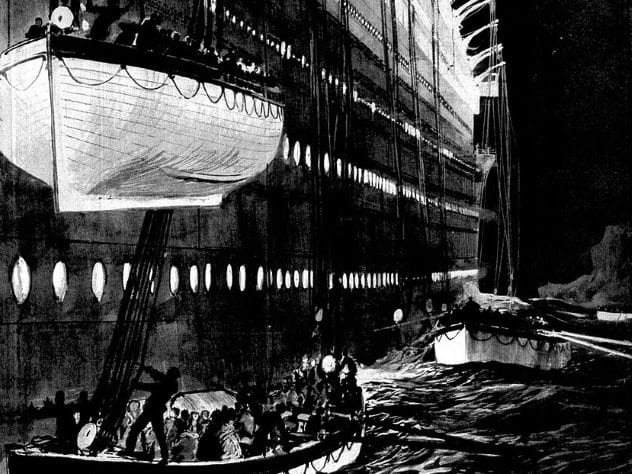
Most people know that Titanic didn’t have enough lifeboats for everyone aboard. At the time Titanic set sail, regulations dictated that she required a total of 16 lifeboats. Titanic not only complied with this but actually carried an additional four smaller boats (“collapsibles”). It’s worth noting that the idea that lifesaving equipment was considered irrelevant on an “unsinkable” ship is clearly false. But if Titanic had carried enough lifeboats to accommodate everyone aboard, would it have really made a difference in terms of loss of life?
The short answer is “no,” and there are a number of reasons for this. Firstly, we know that the last of Titanic‘s boats were launched (if we accept the term “launched” to mean “swept off the deck”) around 2:15 AM, just five minutes before the ship sank completely. In other words, officers didn’t even have enough to time to launch and lower the boats they had. In addition to this, firsthand accounts tell us that many passengers were reluctant to get into the boats, feeling they were safer aboard the ship. Some had to be “convinced” to get into them, while others flat out refused. We also know that those in third class had difficulty finding their way to the boats quickly, if at all.
Storage of the boats created problems, too. For example, Collapsible C couldn’t be set up, let alone launched and lowered, until Boat 1 had been lowered away. Collapsibles A and B were stored on the roof of the officers’ quarters, requiring valuable time to get them down to the boat deck in order to load them. It’s likely that further boats would have been stored in similar difficult-to-reach places, and officers and crew simply wouldn’t have had time to prepare and load them.
While it is true that given the calm sea conditions, a few extra boats may have been helpful in the water (provided they were cut free beforehand), it’s clear that even if Titanic had had enough lifeboats for all aboard, the loss of life would still have been incredibly high. That night, it seems, time was as cruel a mistress to those poor souls as the icy water below them.
6 The Final Moments Of Thomas Andrews
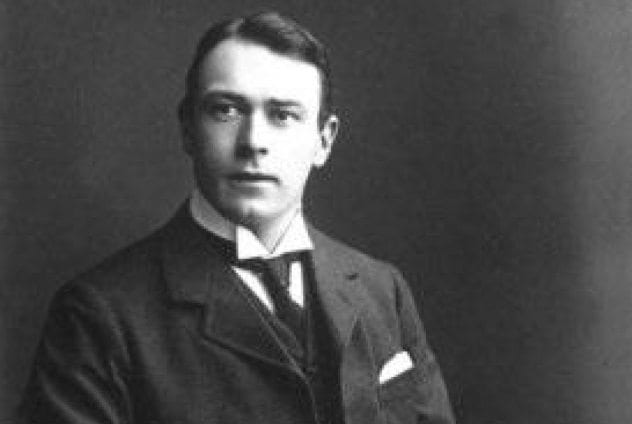
Shipbuilder Thomas Andrews is rightly seen as one of the heroes of the Titanic disaster. However, despite this common conception of the man, it’s interesting that legend has accepted his final moments as a romanticized snapshot of him standing alone in the first-class smoking room, staring morosely at a painting of Plymouth Harbor, a life belt draped over a chair, symbolizing a loss of hope rather than a chance of life. It’s certainly an evocative image, and the moment itself comes from eyewitness testimony. But is it really the way Thomas Andrews met his end?
The eyewitness in question was a steward named John Stewart, and while no one really has any reason to doubt his recollection, the timing of this sighting challenges what we think of as the last moments of Thomas Andrews. Stewart was likely saved in Boat 15, which left the ship around 1:40 AM. This means that his sighting of Andrews in the smoking room occurred at least 40 minutes before the ship actually sank.
There are accounts of later sightings of Andrews that give us a better idea of the man’s final moments. One unnamed survivor recounted seeing Andrews on the boat deck during Titanic‘s final moments, tossing deck chairs overboard to provide something for those still trapped aboard to cling to in the icy water. Mess Steward Cecil William N. Fitzpatrick saw Andrews on the bridge with Captain Smith as Titanic took her final plunge. Reportedly, the captain told him, “We cannot stay any longer—she is going!” They dived into the water together.
It seems, then, that rather than being lost in his own sense of hopelessness, Thomas Andrews actually spent his last moments trying to save the lives of others. As Andrews biographer Shan F. Bullock put it back in 1912, “Whatever he saw in that quiet, lonely minute it did not hold or unman him. Work—work, he must work to the bitter end.”
5 Third-Class Passengers Were Locked Belowdecks

Third-class passengers simultaneously fighting for their lives and fighting the class system is a staple of Titanic movies. Once again, this notion evolved from a spark of truth. Indeed, we know that out of approximately 700 third-class passengers, only around 180 were saved, and there are some accounts of small groups deep inside the ship being prevented from reaching the boat deck. That in itself sounds shocking, but it’s important to remember the context of the situation.
In 1912, immigration laws dictated that ships be strictly divided by class in order to prevent the spread of disease. On open decks, there were low-hinged gates to keep things separate as well as signs throughout the ship. In deeper sections of the ship, some tall Bostwick gates (like you see in the James Cameron movie) were used due to the fact that class sections were interchangeable. The gates provided an easy way to keep things divided. However, how often these gates were actually locked is another issue. Stewards would be expected to make sure that no one found their way into the wrong part of the ship.
On the night of the sinking, many passengers, crew, and even some of the officers were unaware of the seriousness of the situation. Even those who knew Titanic was sinking were hearing rumors that ships were on their way to save them (as soon as within an hour in some cases). In other words, many thought that normal rules still applied. In addition, many chose to stay in their own part of the ship rather than wander around, assuming the situation was under control.
The concept of a deliberate attempt to keep all third-class passengers from reaching the boat deck is easy to believe if we imagine that these few Bostwick gates blocked their only route out of the depths of the ship, but that simply isn’t the case. Third-class passengers had easy access to open decks. Indeed, common areas such as the third-class smoking room, which passengers would have been fully aware of, were located near open decks. Eyewitnesses reported seeing great numbers of third-class passengers making their way up to these open decks.
Unfortunately, there were very few signs directing passengers to the upper decks, a problem only compounded by the amount of third-class passengers who couldn’t speak English. While there are a number of accounts of stewards helping third-class passengers navigate their way through the ship, it’s easy to see how difficult this would have been and how much harder it would have been for passengers attempting to do it alone. Nevertheless, many managed it. The real problem came when trying to access the second- and first-class parts of the ship on the upper decks, and this is where we hear some of the accounts of people being prevented from getting to the boat deck. The evidence we have suggests a great number of third-class passengers did make it up to the boat deck—but not until the last hour of the disaster.
The idea that there was some sort of conspiracy to let third-class passengers die is, frankly, absurd. The truth is that a mixture of mistaken belief in the safety of the ship from both passengers and crew, difficulty in navigating the maze-like layout of the ship, language barriers, and poor organization were the main causes of the disproportionate loss of life in third class.
4 Titanic‘s Hull Number Spelled Out ‘No Pope’
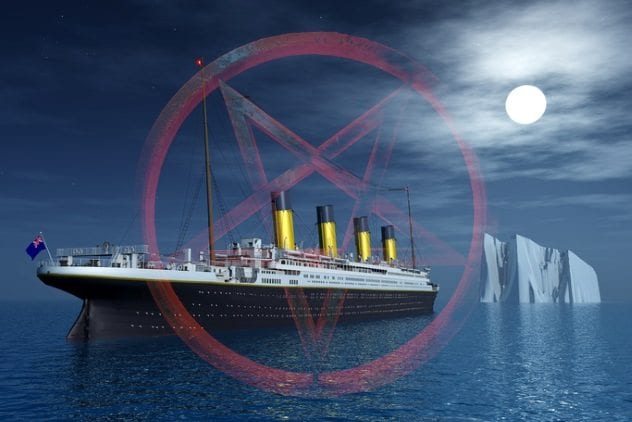
A rumor that began in Titanic‘s hometown of Belfast stated that when the ship’s hull number, 360604, was read with a mirror, it (sort of) spelled out the words “No Pope.” Obviously, this became a popular story in the very religious Belfast, and before long, many were claiming that this demonic hull number was the cause of the sinking.
Sadly, this story falls down at the first hurdle, given that Titanic‘s hull number was 401, which having just experimented, roughly spells out “ROA,” which stands for “Return On Assets.” So, there’s one for the conspiracy theorists.
3 J. Bruce Ismay Was a Mustache-Twirling Villain

From the first dramatic reports of the disaster in 1912, the Titanic story has been akin to flypaper for grand stories of heroes and villains. No one has been a greater victim of this than White Star Line chairman J. Bruce Ismay (cleverly coined “J. Brute Ismay” by the press of the day). The concept of a mustached super-villain bullying officers into sacrificing safety for speed still dominates today. But how true is this image?
The first accusation thrown Ismay’s way is often that of cutting corners during Titanic‘s construction, favoring money over pointless little inconveniences like passenger safety. It’s true that Ismay was a businessman, and as such, there can be no doubt that keeping costs down would have been a priority. However, evidence suggests that Ismay was quite happy to comply with Board of Trade regulations and was willing to spend a little more on extra boats (and newly designed davits that would allow for the inclusion of even more boats if the regulations were increased). It would be unfair to say that he did this purely out of the goodness of his heart and fairer to say that it was an investment for the future. Nevertheless, it certainly doesn’t indicate that he was a Scrooge-esque miser in a darkened room, desperately trying to scrape money off the surface of safety to line his own pockets. Indeed, to do so would have been foolish. The safer and sturdier the ship was, the more money it would make in the future. Furthermore, any attempt to trick the Board of Trade would have led to a poor reputation, which wouldn’t have been good for business.
The next accusation Ismay is loaded with is that of a deliberate attempt to bully and cajole the captain and his officers into speeding up beyond the bounds of safety, blinded by a need for glory and renown. But Ismay himself was a passenger. To place those aboard in danger would mean to do so to himself, which would be daft beyond measure. Passenger Elizabeth Lines reported overhearing a conversation between Captain Smith and Ismay about the ship’s progress, in which Ismay sounded bright, optimistic, and content with the ship’s progress so far. Ismay was overheard talking about “beating” Titanic‘s sister ship Olympic‘s speed record, which when you think about it, isn’t all that odd a thing to say or hope for. The possibility of Titanic making it to New York a day early was well-known to both the crew and the passengers from the start of the voyage. Either way, Captain Smith was the authority on the ship, and in truth, he had little to fear from Ismay. Smith was was a big money-maker for the White Star Line, nicknamed the “Millionaire’s Captain,” due to his popularity with high society. Indeed, his presence as commander helped the sale of tickets. The idea that Ismay could really pressure Smith beyond the realms of pointed suggestion is pretty unlikely.
Some survivors later described Ismay telling them that speed would be increased later in the voyage. This was not unusual. In clear weather, it was very common for ships, particularly on their maiden voyage, to travel at full speed where possible. However, on the night of April 14, when Titanic hit the iceberg, the ship was not traveling at full speed. The plan had been to work her up to that on April 15 or 16, weather allowing. Titanic was certainly traveling faster than she had so far, but she hadn’t reached full speed at that stage. In addition, contrary to popular belief, rather than dismissing iceberg warnings as unimportant and focusing on speed, Titanic‘s officers took them seriously. They informed the lookouts, and the captain ordered that at the slightest deterioration of the weather, they should slow down.
So what of Ismay after the collision? It’s well-known that he was saved in a lifeboat, an act he paid for for the rest of his life. What’s less-known is that the boat he was saved in was one of the last to be properly launched. It’s also less-known that this boat also carried another male first-class passenger and four stowaways. The circumstances surrounding his getting into the boat are up for debate, and many feel it is irrelevant, given the fact he represented the White Star Line and should have stayed aboard the ship. But it is worth pointing out that up until the point in which he got into the lifeboat, he was seen up on the boat deck for most of the night, helping women and children into boats. He was even seen encouraging and convincing those reluctant to go, injecting a sense of urgency that was missing in other parts of the ship. It could be argued that Ismay helped to save lives that night.
Whether one considers Ismay a coward who should never have attempted to survive or a man who acted on instinct and paid for it dearly, the truth is that the evil, mustache-twirling caricature that is often portrayed is not really accurate. He certainly cannot be blamed for the sinking or even the amount of lives lost.
2 Titanic Sank Because A Coal Bunker Fire Weakened Her Hull
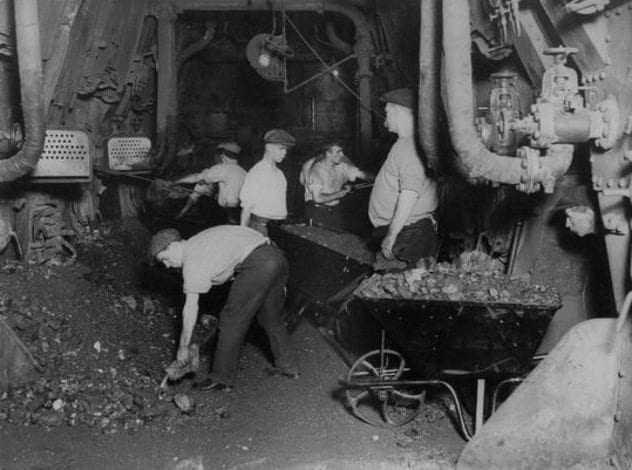
This is an old theory that has reemerged of late thanks to a recent documentary. New photos came to light, showing a “smudge” along the starboard hull of Titanic (the same side that struck the iceberg). The theory suggests that a coal fire burning in one of the bunkers had weakened the structure of the ship. If it hadn’t been for the fire, the ship wouldn’t have been so severely damaged by the collision with the iceberg and wouldn’t have sunk.
A coal bunker fire was indeed burning away during Titanic‘s maiden voyage. While not exactly common, it wasn’t an exceptional circumstance on a coal-powered ship, either. Procedures were in place to deal with it, and the crew did just that, eventually managing to extinguish the fire by the day of the disaster. The biggest problem with this theory is that the “smudge” that supposedly shows damage to Titanic‘s hull is located approximately 15 meters (50 ft) away from where the fire was actually burning. Further, the suggestion that cost-cutting measures led to a weaker hull that was unusually susceptible to fire damage has no evidence to support it. There is no credible evidence to suggest the structural elements of Titanic‘s hull were insufficient.
Interestingly, there is a theory that the fire may have actually been a help rather than a hindrance. If some of the starboard bunkers had been emptied in order to deal with the fire, it could explain why the Titanic did not capsize to the starboard side right after the collision. Either way, the damage Titanic sustained due to the collision is pretty much what would be expected for any ship in that situation.
1 Captain Smith Was Going To Retire After Titanic‘s Maiden Voyage
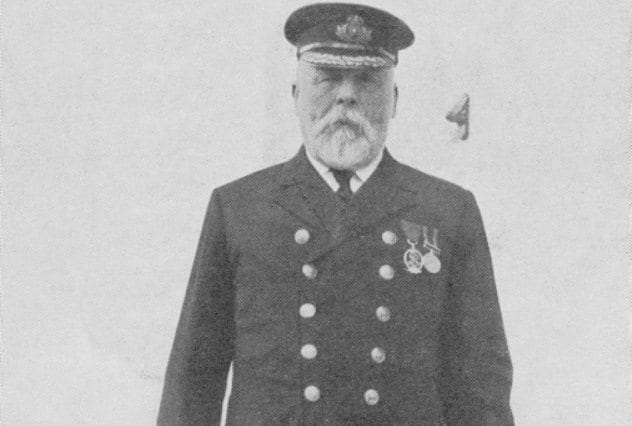
There’s no denying that the gut-wrenching sadness of the Titanic disaster is only amplified by the thought that its captain was planning to use her maiden voyage as the metaphorical cherry on his illustrious career. What better way to say goodbye to lifetime at sea than on the great Titanic? And what horror to think that such a lifetime came to such an abrupt, tragic end. It’s a longtime staple of Titanic legend, and it’s easy to see why.
The truth however, isn’t quite so dramatic. It’s true that Captain Edward John Smith was in the darker end of the twilight of his career. But there is actually no evidence to suggest that Titanic‘s maiden voyage was meant to be his last.
Unlike most of the misconceptions on this list, this particular rumor began before Titanic even set sail. In 1911, just before Titanic‘s sister ship, the Olympic, set sail on her maiden voyage under the command of Captain Smith, The New York Times reported it was understood that Captain Smith would retire by the end of the year due to his age. The article went on to suggest that on her maiden Voyage, Olympic‘s younger sister Titanic would be under the command of Captain Bertram Hayes. Indeed, the question of who would command Titanic appeared to have been undecided, with J. Bruce Ismay indicating that the aptly named Captain Haddock (not of Tintin fame) would take the helm. By the end of 1911, it was being reported that Smith would indeed take charge of Titanic but only until his retirement in the summer of 1912.
On April 11, 1912, as Titanic was beginning to make her way across the Atlantic, The New York Times reported that rumors suggested this would indeed be Smith’s last voyage. This, however, was denied by the White Star Line, which said that Smith would take command of Titanic until he had the opportunity to command “a larger and finer vessel” (perhaps Titanic’s younger sister ship, later named Britannic, which was under construction).
It’s seems likely then that Smith was indeed planning to retire, but his popularity had led to his staying on longer. Given his popularity, it would not be unreasonable to assume that the rumors of his impending retirement were helping nicely with business, giving an added incentive to travel on Titanic. Sadly, we will never know for sure what Smith’s actions would have been after Titanic‘s maiden voyage. Whatever he might have done, it’s fair to say that had he wished to continue, he had opportunity to do so, and there’s no reason to assume that Titanic‘s maiden voyage would have been his last.
Nancy Lourido is a writer and researcher with 29 years of experience in the field of procrastination.


